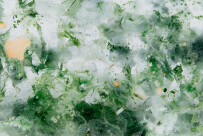A collaboration between Snøhetta, Studio Plastique and Fornace Brioni, Common Sands – Forite positively leverages the unique properties of composition, colour and structure inherent in sand as a waste material into a series of architectural glass tiles. Emphasis has been put on waste glass from ovens and microwaves as a starting point to demonstrate the aesthetic depth, function and potential of the recycled material, but the project is not limited to this material stream alone.

Though typically associated with beaches and playgrounds, sand is a precious resource essential to the continued functioning of a society increasingly reliant on technology. Integral to the production of microchips, fiberoptic cables, insulation and solar cells, sand is also a particularly essential component in the glass that is used in our daily devices.

While great efforts have gone into efforts to extract, transport, refine and process sand into electronic components, little has been done to recycle these components when electronic goods reach the end of their lives.

Drawing from a body of existing material research by Studio Plastique, Common Sands – Forite evolved as a collaborative research project between Studio Plastique and Snøhetta, intending to explore the potential applications of recycled E-waste glass. Through several prototypes and variations, a process for recycling E-waste glass components was developed, leading to the development of an application integrating and celebrating its variable material quality: glass tiles.

Italian ceramic tile manufacturer Fornace Brioni later joined the team, bringing their experience, industrial know-how, production facilities and potential for scalability to the project.

Made from recycled glass from microwave ovens, the tiles have been developed in two different sizes. The tiles are both opaque and transparent, each with a unique pattern and expression. With a deeply complex, terrazzo-like material quality, they are suitable for a wide range of architectural applications, including both surface coverage and semi-transparent partition elements.







































